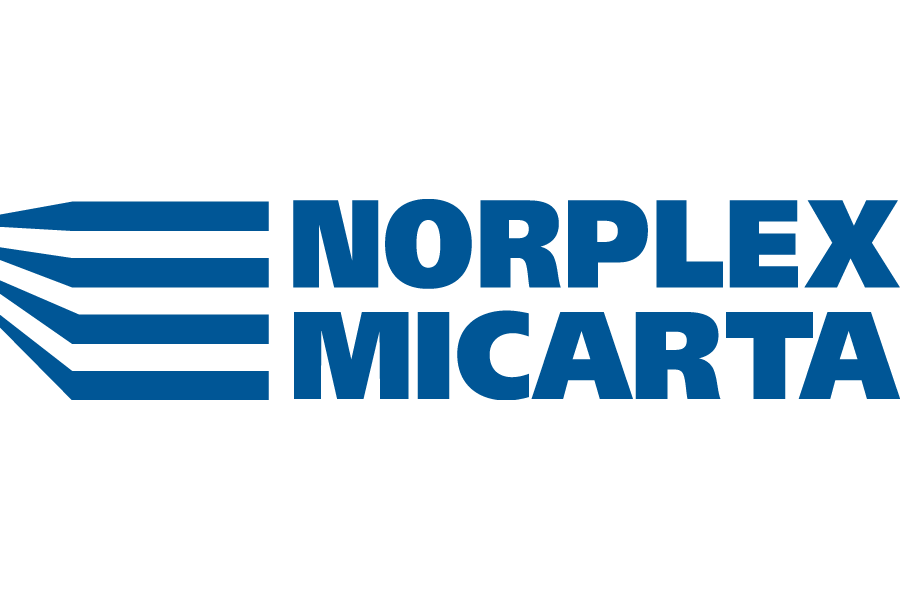Thermoset Composites as Bearing and Wear Materials
Norplex-Micarta
A 2015 study by Holmberg and Erdemir estimated that 20% of the total energy produced worldwide is used to overcome friction [1]. This shows just how important the study of friction and the means to overcome it are. Friction is invariably present in dynamic machines that involve moving parts and it greatly reduces the efficiency of these machines if not properly controlled. Furthermore, it may damage the parts involved via wear as pieces of the materials fall off as they rub against each other constantly over time. To overcome these problems, lubricants, special materials and mechanisms (bearings) are designed. These materials are typically metal, but can thermoset composites produce equal or even better results?
Bearings are a very efficient method of reducing friction, especially as they eliminate the problems associated with lubrication, such as disposal and frequent replacement. Thus, they have become key to many systems that involve relative motion. Various materials are used to make bearings, considering their properties and how well they meet the unique requirements for each application. In recent times, thermoset composites are proving to be a viable alternative to metals. The materials of interest in this article are the EndurX™ line made by Norplex-Micarta, which are specifically designed to be used in bearings and other applications where resistance to wear is crucial.
Introduction to thermoset composites
Thermoset polymers are polymers that, once set (cooled and solidified from their liquid form), cannot revert into their original liquid form. Therefore, this process of setting is irreversible. These polymers, used as resin base, are imparted with various additional properties (primarily strength) through the introduction of composite additives, usually in the form of fibre reinforcement. The resulting material is referred to as a thermoset composite. Given a certain set of required properties, the choice of resin polymers and reinforcement composites, as well as the relative quantities of their combination, are determined.
EndurX™ in bearing and wear applications
To be a viable material option for bearings and wear-resistant applications, such a material may need to exhibit several properties, including excellent strength, wear resistance, good electrical insulation, thermal conductivity, shock resistance, self-lubricating, and low moisture absorption. A few of these properties will be examined to see how well the EndurX™ materials fare as bearing and wear materials.
Wear resistance
This is one of the most important properties of a material to be used in the manufacture of bearings, where friction is expected to be virtually zero. When this happens, wear will consequently be minimised to near zero, as well. Composite materials with good wear resistance require sturdiness to withstand load and the capability to be machined into the required smooth finish for a near frictionless surface.
Mechanical properties
Mechanical properties, such as tensile, flexural, and compressive strength, can be increased or decreased with changes in the reinforcement. Paper, linen, canvas and heavyweight canvas allow the engineer to qualify the appropriate material for their application. The BP81NPN sheet, one of the strongest materials in the EndurX line, achieves a tensile and compressive strength of 296.5 MPa with a Rockwell hardness of 100.
Thermal and Electrical Insulation
Phenolic resins are desirable because of their heat resistance and dimensional stability, which is why when combined with various natural fibre, it makes them suitable for many high-temperature applications. Some applications, such as trunnion wheels, exceed what standard materials can handle for thermal insulation and mechanical properties as they do not dissipate heat quickly enough. These problems can be mitigated by introducing metal wires, which helps to remove heat and improve dimensional stability.
Electrical insulation can be important in certain bearing applications, such as electric motors and generators, where the passage of current through the bearing and phenomena like galvanic corrosion are undesirable. Thermoset composites that require this feature cannot contain additives that are electrically conductive such as graphite lubrication. The material BP21NPN shows good performance under electrical conditions with an arc resistance of 15 seconds and dielectric strength of 17.72 - 22.64 kV/mm.
Self-lubrication
Many modern bearing applications require self-lubrication to allow for “dry running” and eliminate the risk of coolant/lubricant leakage and corrosion. The EndurX line makes it possible to add lubricants to the resin system. Graphite, molybdenum disulfide and PTFE are gradually released onto the mating surfaces, creating a lubricating film that will keep the bearing lubricated throughout its operational life.
Moisture absorption
Some bearing applications, such as hydroelectric equipment and rudders of marine vessels, require constant contact with water. In such applications, moisture absorption must be very low to limit swelling. Swelling can catastrophically impact a part’s function as bearing applications typically have low clearances and dimensional tolerances. Appropriate reinforcements must be selected to ensure that the part does not readily absorb water. The material BT25HEE has one of the lowest moisture absorptions of the EndurX series, with a value of 0.70%.
Table 1. Properties of selected EndurX™ Tubes
|
Reinforcement Substrates |
Cotton canvas |
Cotton (fine weave linen) |
|||
|
Resins |
Phenolic |
Phenolic |
Phenolic |
Epoxy |
Phenolic graphite |
|
Grade |
BT12HPN |
BT13SPN |
BT22NPN |
BT25NEE |
BT25NPG |
|
Physical properties (at 0.750″ ID x 1.000″ OD) |
|||||
|
Specific Gravity |
1.3 |
1.3 |
1.29 |
1.33 |
1.3 |
|
Rockwell Hardness (M scale) |
90 |
95 |
100 |
110 |
90 |
|
Moisture Absorption (%) |
1.7 |
1.4 |
1.2 |
1.5/0.9 |
1.5 |
|
Tensile Strength (PSI) |
7600 |
7300 |
10000 |
12500 |
10500 |
|
Compressive Strength (PSI) |
27500 |
28500 |
30000 |
30000 |
23500 |
|
Compressive Modulus (PSI) |
250 |
440 |
425 |
470 |
- |
|
Thermal properties |
|||||
|
Temperature Index, °C (Electrical / Mechanical) |
130/130 |
140/140 |
125/125 |
140/140 |
-/125 |
|
Flammability Rating U.L. 94, Class (0.062″) |
HB |
HB |
HB |
HB |
HB |
|
Electrical properties (0.750″ ID x 1.000″ OD) |
|||||
|
Electric Strength, V/mil |
225 |
150 |
190 |
350 |
- |
Table 2. Properties of selected EndurX™ Sheets
|
Reinforcement Substrates |
Cotton canvas |
Cotton (fine weave linen) |
|||
|
Resins |
Phenolic |
Phenolic - MoS2 |
Phenolic - Graphite |
Phenolic |
Phenolic - PTFE |
|
Grade |
BP11NPN |
BP13NPM |
BP14NPG |
BP21NPN |
BP25NPP |
|
Physical properties (at 0.750″ ID x 1.000″ OD) |
|||||
|
Specific Gravity |
1.37 |
1.4 |
1.41 |
1.34 |
- |
|
Rockwell Hardness (M scale) |
100 |
100 |
100 |
100 |
- |
|
Moisture Absorption (%) |
3.5 |
1.95 |
2.5 |
2.3 |
1.19 |
|
Flexural Strength (psi) |
18000/17000 |
19000/17000 |
20000/18000 |
24500/18500 |
22000/21500 |
|
flexural Modulus (kpsi) |
1600/1500 |
1200/1000 |
1300/1000 |
1700/1300 |
- |
|
Tensile Strength (psi) |
12000/9700 |
11000/9000 |
11000/9000 |
14000/10000 |
- |
|
Izod Impact Strength - notched (ft-lb/in) |
3.1/2.7 |
1.7/1.4 |
-/- |
1.7/1.35 |
1.96/1.46 |
|
Compressive Strength (psi) |
34000 |
36000 |
36000 |
38000 |
- |
|
Bonding strength (lb) |
2500 |
1900 |
2000 |
2000 |
1370 |
|
Shear strength (psi) |
14000 |
13500 |
13000 |
13500 |
- |
|
Thermal properties |
|||||
|
Temperature Index1, °C (Electrical / Mechanical) |
115/125 |
-/145 |
-/145 |
115/125 |
- |
|
Coefficient of Thermal Expansion (0.125″) |
20/22 |
18/24 |
18/22 |
18/19 |
- |
|
Flammability Rating U.L. 94, Class (0.062″) |
HB |
HB |
HB |
HB |
HB |
|
Electrical properties (at 0.062″) |
|||||
|
Breakdown Voltage, kV (0.062″) |
20 |
- |
- |
45 |
25 |
|
Electric Strength, V/mil (0.062″) |
400 |
- |
- |
575 |
- |
|
Arc Resistance D495, sec (0.125″) |
15 |
- |
- |
15 |
- |
|
Comparative Tracking Index D3638, V (0.125″) |
155 |
- |
- |
170 |
- |
EndurX™ materials come in a lot of combinations between resin, reinforcement, and other additives. Norplex-Micarta has designed a naming convention that helps to easily understand the constituents of every grade. This convention consists of five parts, namely:
- Form: this refers to the shape the material is fashioned in, such as sheets (BP), tubes (BT), rods (BR), and it is designated with the first two letters.
- Reinforcement: this is the material that serves as reinforcement for the resin. It could be cotton (10 – 19), linen (20 – 29), synthetic fibres (30 – 49), etc., and it is denoted by the following two letters.
- Designator: this is reserved to denote different construction, and it is the fifth letter.
- Resin: this denotes the type of resin used. and it is most commonly phenolic resin, but it could be epoxy, as well. It is represented by the sixth letter.
- Additive code: this indicates the type of additives in the material that has been added to improve performance, and it can be alumina (A), graphite (G), molly (M), PTFE (P) or denoted as N if there have been no additives. The additive code is represented by the last letter.
Why should you choose EndurX™ from Norplex-Micarta?
Norplex-Micarta thermoset composites are made by mixing a resin with reinforcements. The combination undergoes a high-temperature and high-pressure curing process, which creates a cross-linked molecular structure, resulting in a material that does not melt. This production technique allows new composite materials to be made which have properties far beyond the sum of their components. Standard materials are available for research and development purposes, while customised products can be made to meet specific industry needs. The EndurX™ series are available in sheets and tubes.
Visit the Norplex-Micarta supplier page for more information on their materials listed on Matmatch and to get in direct contact with them.
Artikel von <a href=/suppliers/nomi-norplex-micarta-> Norplex-Micarta </a>Norplex-Micarta
Norplex-Micarta is a leading manufacturer of high-performance thermoset composite materials based on impregnation and lamination technology. Norplex-Micarta manufactures the highest quality specialty sheet products, pre-pregs, rods, molded shapes, and tubes to meet demanding applications for OEMs and fabricators around the world.

